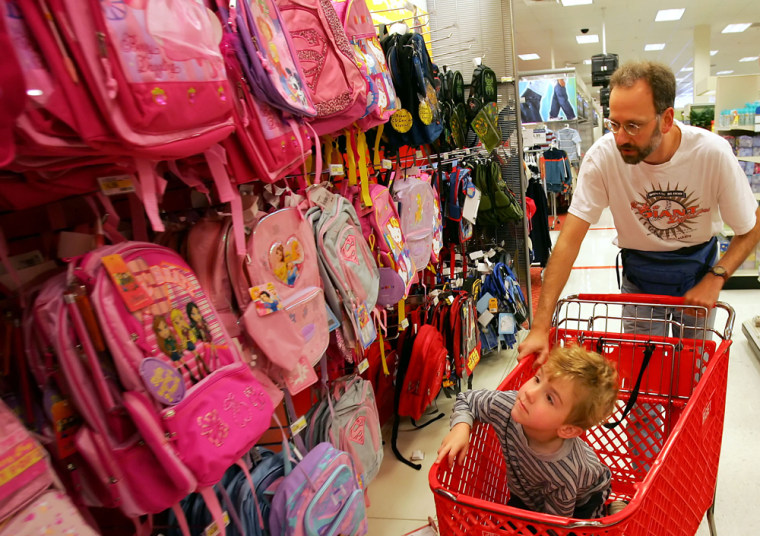With visions of three-ring binders dancing in their heads, retailers are understandably giddy this time of year. Back-to-School may not be much to celebrate for kids or their parents, but retailers consider it the second biggest "holiday" of the year after Christmas.
And this year it could be significantly bigger. The National Retail Federation expects $17.6 billion will be spent, up from 2005’s $13.4 billion.
“People are surprised when they add it all up,” says Mary Navarro, senior executive vice president of retail and commercial banking for Columbus, Ohio-based Huntington Bancshares. To help families prepare for their school shopping sprees, Huntington developed the Backpack Index. Actually, it is three indexes, each created by pricing school supplies lists from dozens of elementary, middle and high schools, then adding in activities fees to make budgeting as realistic as possible.
Using the index, the bottom line for a child in elementary school is $307.55. For middle schoolers it is $438.69. The budget for high school students is a whopping $669.93, yet still excludes the extra expenses seniors incur. None of the indexes take clothing into account since it is a year-round expense for most families.
Navarro says the bank hopes the indexes will help parents plan ahead, even create a year-round savings plan to avoid being caught off-guard by high credit card bills each September.
Kim Jones of Richton Park, Ill., may not keep a running total of her school-related spending, but the working mom already has a well-planned shopping strategy to make every dime count when shopping for her two sons.
“I am the parent who asks for the school list before school ever lets out,” said Jones, who then watches for sales throughout the summer. Her biggest payoff so far, finding spiral notebooks for a dime each. “I bought 24,” she said.
But while Jones has a strategy for controlling her store-bought expenses, she is amazed at the rising cost of things she cannot control like school-registration fees. Her sons’ combined fees jumped from $95 dollars to $175 this year.
“I really do not know how bigger families afford it all,” says Suzanne Patterson of Homewood, Ill., “It is just incredible how much the spending jumps with each grade.” She expects to spend $100 on registration fees and another $100 to $150 on supplies this year for her son, with more of her money being spent on electronics. Her son’s school requires each student to have headphones and a jump drive.
“Electronics is a growing back-to-school category for us,” confirms Mindy Kramer, a spokesperson for Office Depot. “Students are buying MP3 players to use to record classes [and to listen to books and lectures]. It’s a category that started out as entertainment, but is becoming a back-to-school item for us.”
Also pushing electronics spending — which the National Federation of Retailers credits for much of the expected rise in spending this year — are the so-called thumb or jump drives that store computer data on easy-to-carry device. “It is certainly more expensive than crayons and binders, but it makes the portability of schoolwork possible,” says Kramer.
Office Depot began seeing heavy back-to-school traffic during the last two weeks of July. That not so coincidentally was the start of the Sales Tax Holiday season — for retailers, a holiday within a holiday given the crowds it brings into stores. Currently thirteen states have declared these ‘holidays’ to coincide with back-to-school shopping.
“They are very popular events,” confirms Verenda Smith, government affairs associate with the Federation of Tax Administrators in Washington, D.C. States use them to help ease the financial burden of back-to-school spending. “People who wouldn’t think of crossing the street for a 5 percent off sale will take the whole day off from work to save the sales tax on select purchases,” she notes.
Realistically, with savings of about $20 being realized on $400 worth of school supplies and clothing, not only will such savings not fill the gas tank of the family minivan, they offer little relief to families actually struggling to load their children’s backpacks for school.
For those families, retailers like Office Depot donate supplies for distribution through a variety of local organizations across the country. “Some of our stores even sponsor supplies drives at the local level,” says Kramer. At the corporate level, the retailer plans to distribute 300,000 supply-filled backpacks this year.
Among the organizations helping to distribute those backpacks is the SHOPA Kids in Need Foundation. SHOPA also accepts donations from individuals, local groups and excess inventory from any size retailer. Communities In Schools, the nation’s largest stay-in-school organization, is also working with Office Depot and individuals at the community level to gather supplies and cash donations.
Regardless of where or when one does back-to-school shopping, SHOPA thinks it offers an opportunity to demonstrate the importance of strategic spending to kids. They suggest involving school-age children in planning purchases and making a game of comparison shopping. According to SHOPA, even the dreaded back-to-school shopping trip can serve as quality family time and lead the way to a lifetime of financial savvy, which truly is a bargain.
